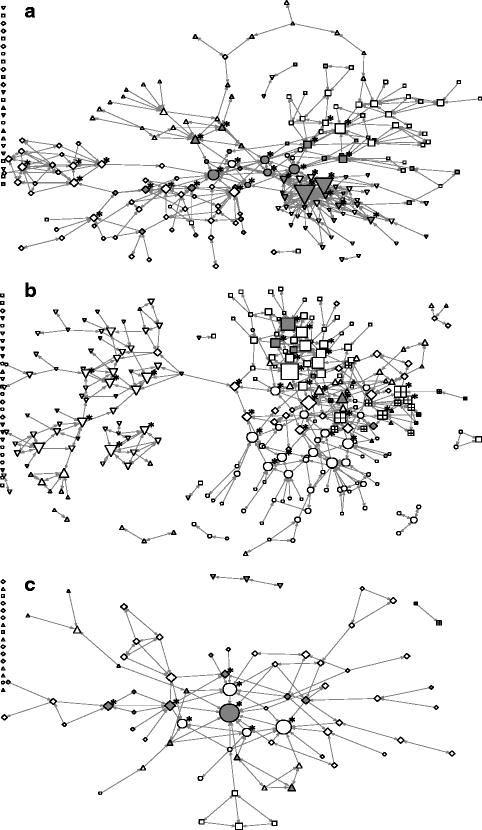Implementation of evidence-informed practice through central network actors; a case study of three public health units in Canada
- PMID: 28298209
- PMCID: PMC5353959
- DOI: 10.1186/s12913-017-2147-x
Implementation of evidence-informed practice through central network actors; a case study of three public health units in Canada
Abstract
Background: Workforce development is an important aspect of evidence-informed decision making (EIDM) interventions. The social position of individuals in formal and informal social networks, and the relevance of formal roles in relation to EIDM are important factors identifying key EIDM players in public health organizations. We assessed the role of central actors in information sharing networks in promoting the adoption of EIDM by the staff of three public health units in Canada, over a two-year period during which an organization-wide intervention was implemented.
Methods: A multi-faceted and tailored intervention to train select staff applying research evidence in practice was implemented in three public health units in Canada from 2011 to 2013. Staff (n = 572) were asked to identify those in the health unit whom they turned to get help using research in practice, whom they considered as experts in EIDM, and friends. We developed multi-level linear regression models to predict the change in EIDM behavior scores predicted by being connected to peers who were central in networks and were engaged in the intervention.
Results: Only the group of highly engaged central actors who were connected to each other, and the staff who were not engaged in the intervention but were connected to highly engaged central actors significantly improved their EIDM behavior scores. Among the latter group, the staff who were also friends with their information sources showed a larger improvement in EIDM behavior.
Conclusions: If engaged, central network actors use their formal and informal connections to promote EIDM. Central actors themselves are more likely to adopt EIDM if they communicate with each other. These social communications should be reinforced and supported through the implementation of training interventions as a means to promoting EIDM.
Keywords: Centrality; Evidence-informed decision-making; Local opinion leaders; Social network analysis.
Figures

Similar articles
-
The evolution of social networks through the implementation of evidence-informed decision-making interventions: a longitudinal analysis of three public health units in Canada.Implement Sci. 2015 Dec 3;10:166. doi: 10.1186/s13012-015-0355-5. Implement Sci. 2015. PMID: 26634923 Free PMC article.
-
Informing the implementation of evidence-informed decision making interventions using a social network analysis perspective; a mixed-methods study.BMC Health Serv Res. 2017 Feb 8;17(1):122. doi: 10.1186/s12913-017-2067-9. BMC Health Serv Res. 2017. PMID: 28178958 Free PMC article.
-
Barriers, facilitators and views about next steps to implementing supports for evidence-informed decision-making in health systems: a qualitative study.Implement Sci. 2014 Dec 5;9:179. doi: 10.1186/s13012-014-0179-8. Implement Sci. 2014. PMID: 25476735 Free PMC article.
-
Strategies to implement evidence-informed decision making at the organizational level: a rapid systematic review.BMC Health Serv Res. 2024 Apr 1;24(1):405. doi: 10.1186/s12913-024-10841-3. BMC Health Serv Res. 2024. PMID: 38561796 Free PMC article.
-
Knowledge translation strategies for enhancing nurses' evidence-informed decision making: a scoping review.Worldviews Evid Based Nurs. 2014 Jun;11(3):156-67. doi: 10.1111/wvn.12043. Worldviews Evid Based Nurs. 2014. PMID: 24934565 Free PMC article.
Cited by
-
Developing a typology of network alteration strategies for implementation: a scoping review and iterative synthesis.Implement Sci. 2023 Apr 6;18(1):10. doi: 10.1186/s13012-023-01266-3. Implement Sci. 2023. PMID: 37024916 Free PMC article.
-
Impact of an organization-wide knowledge translation strategy to support evidence-informed public health decision making.BMC Public Health. 2018 Dec 29;18(1):1412. doi: 10.1186/s12889-018-6317-5. BMC Public Health. 2018. PMID: 30594155 Free PMC article.
-
Practitioner perspectives on building capacity for evidence-based public health in state health departments in the United States: a qualitative case study.Implement Sci Commun. 2020;1:34. doi: 10.1186/s43058-020-00003-x. Epub 2020 Feb 25. Implement Sci Commun. 2020. PMID: 32856021 Free PMC article.
-
Equipping the Public Health Workforce of the Future: Evaluation of an Evidence-Based Public Health Training Delivered Through Academic-Health Department Partnerships.J Public Health Manag Pract. 2025 Jan-Feb 01;31(1):51-60. doi: 10.1097/PHH.0000000000001985. Epub 2024 Aug 9. J Public Health Manag Pract. 2025. PMID: 39121436 Free PMC article.
-
A description of a tailored knowledge translation intervention delivered by knowledge brokers within public health departments in Canada.Health Res Policy Syst. 2019 Jun 20;17(1):63. doi: 10.1186/s12961-019-0460-z. Health Res Policy Syst. 2019. PMID: 31221187 Free PMC article.
References
MeSH terms
Grants and funding
LinkOut - more resources
Full Text Sources
Other Literature Sources

